The Intel Core i7-8086K Review
by Ian Cutress on June 11, 2018 8:00 AM EST- Posted in
- CPUs
- Intel
- Core i7
- Anniversary
- Coffee Lake
- i7-8086K
- 5 GHz
- 8086K
- 5.0 GHz
Benchmarking Performance: CPU Rendering Tests
Rendering tests are a long-time favorite of reviewers and benchmarkers, as the code used by rendering packages is usually highly optimized to squeeze every little bit of performance out. Sometimes rendering programs end up being heavily memory dependent as well - when you have that many threads flying about with a ton of data, having low latency memory can be key to everything. Here we take a few of the usual rendering packages under Windows 10, as well as a few new interesting benchmarks.
All of our benchmark results can also be found in our benchmark engine, Bench.
Corona 1.3: link
Corona is a standalone package designed to assist software like 3ds Max and Maya with photorealism via ray tracing. It's simple - shoot rays, get pixels. OK, it's more complicated than that, but the benchmark renders a fixed scene six times and offers results in terms of time and rays per second. The official benchmark tables list user submitted results in terms of time, however I feel rays per second is a better metric (in general, scores where higher is better seem to be easier to explain anyway). Corona likes to pile on the threads, so the results end up being very staggered based on thread count.

Corona is a fully multi-threaded test, so it is surprising to see the 8086K lag behind the 8700K here. This is likely a scenario where the fact that our borrowed testbed setup doesn't perfectly match our standard testbed is playing a factor.
Blender 2.78: link
For a render that has been around for what seems like ages, Blender is still a highly popular tool. We managed to wrap up a standard workload into the February 5 nightly build of Blender and measure the time it takes to render the first frame of the scene. Being one of the bigger open source tools out there, it means both AMD and Intel work actively to help improve the codebase, for better or for worse on their own/each other's microarchitecture.
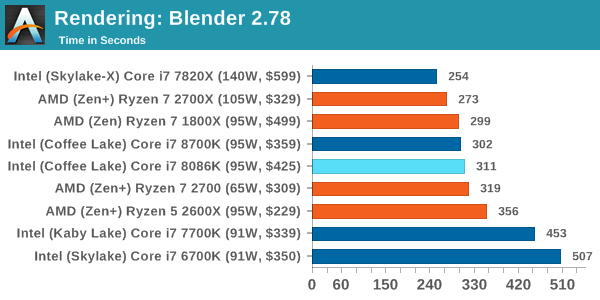
Blender also likes to load up the threads, and the 8086K is behind again.
LuxMark v3.1: Link
As a synthetic, LuxMark might come across as somewhat arbitrary as a renderer, given that it's mainly used to test GPUs, but it does offer both an OpenCL and a standard C++ mode. In this instance, aside from seeing the comparison in each coding mode for cores and IPC, we also get to see the difference in performance moving from a C++ based code-stack to an OpenCL one with a CPU as the main host.
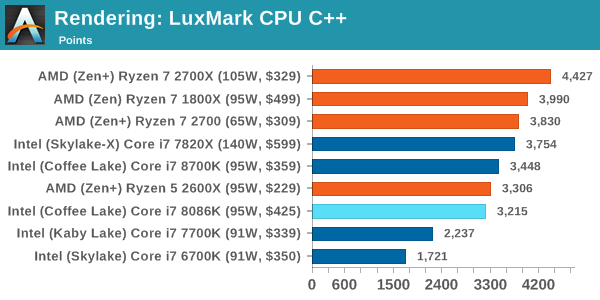

POV-Ray 3.7.1b4
Another regular benchmark in most suites, POV-Ray is another ray-tracer but has been around for many years. It just so happens that during the run up to AMD's Ryzen launch, the code base started to get active again with developers making changes to the code and pushing out updates. Our version and benchmarking started just before that was happening, but given time we will see where the POV-Ray code ends up and adjust in due course.
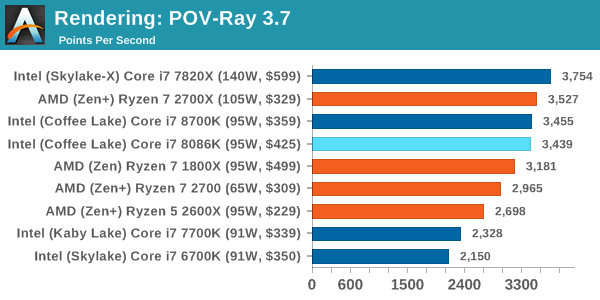
Virtually identical scores between the 8086K and 8700K in POV-Ray.
Cinebench R15: link
The latest version of CineBench has also become one of those 'used everywhere' benchmarks, particularly as an indicator of single thread performance. High IPC and high frequency gives performance in ST, whereas having good scaling and many cores is where the MT test wins out.
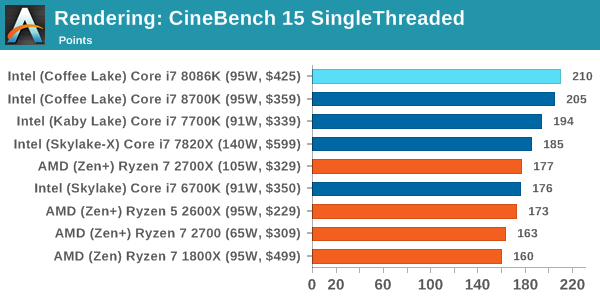
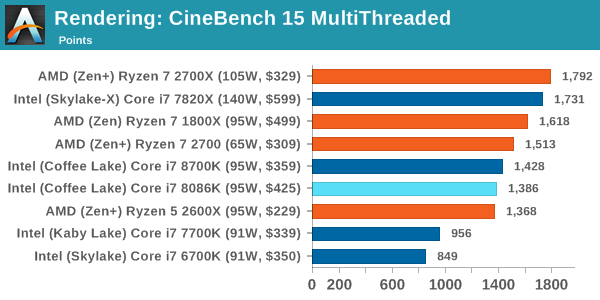
The 8086K gets a new fastest single core score in CineBench R15 ST, but falls slightly behind the 8700K in MT.










111 Comments
View All Comments
Hxx - Thursday, June 14, 2018 - link
who said binned chips? that would imply added costs. Did intel make some official statement? There is now way the 8086ks are binned chips. Intel clocked the 4.7ghz core to 5ghz on a 8700k. That's doable on any cooler you dont need a binned chip for that. Perhaps additional testing was done to make sure they're stable but there is no way intel cherry picked these chips.AutomaticTaco - Monday, June 11, 2018 - link
Okay. So people make purchases. So be it. If it's not better you can purchase something else. And others can make up their own minds.LemmingOverlord - Monday, June 11, 2018 - link
No real explanation why the 8086K underperforms the 8700K in multithreaded CPU tests, then. Considering they are rated the same at more than dual-core usage I can't really understand.Utter waste of money, that's for sure
Ryan Smith - Monday, June 11, 2018 - link
As noted in the testbed section, this wasn't run on our standard testbed since Ian didn't have it with him in Taiwan. Every motherboard is different, sometimes infuriatingly so.AsParallel - Monday, June 11, 2018 - link
Because ASRock and configuration. ASRock boards are a pain to dial in, and sometimes their firmware is an immovable object.artifex - Monday, June 11, 2018 - link
Waiting for the i7-80286K, so I can hit the turbo buttonTheinsanegamerN - Monday, June 18, 2018 - link
I'm waiting for the AMD 5x86 4700x that will slot into an intel motherboard.AsParallel - Monday, June 11, 2018 - link
Purchased one for me and a few to sit on the shelf for 10 years. Just in time for the 50th :)peevee - Friday, June 15, 2018 - link
Hopefully, by that time x64 will die.Jad77 - Monday, June 11, 2018 - link
I don't feel so bad about missing the contest now. How I managed to be so completely out of loop is baffling.